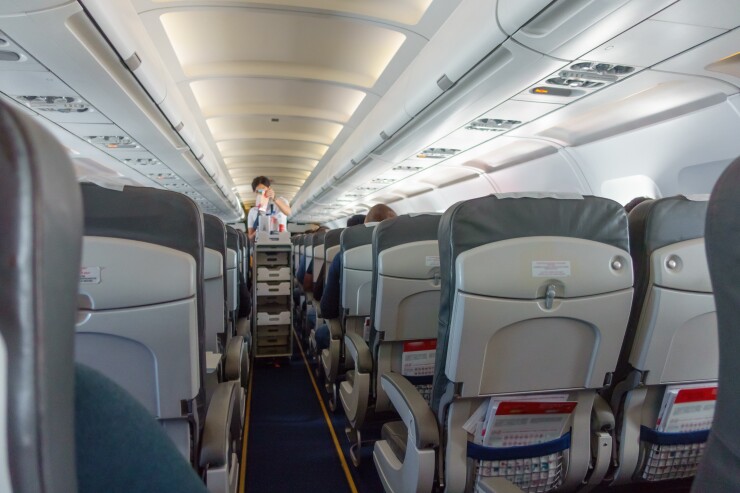There's a clear interest in the airline industry in improving onboard payments, but innovations still lag the terrestrial retail sectors that have pushed advancements in mobile ordering, loyalty and in-app payments.
Guestlogix, a Toronto-based onboard and offboard retail technology company, is working to modernize in-flight payments with a new commerce platform it plans to launch this month for the airline industry. Guestlogix's platform will attempt to work around the myriad problems that hinder shopping on planes.

"We're trying to do something similar to Uber Eats or Starbucks by solving the behind the scenes connectivity issues," said Robin Hopper, senior vice president of product development and marketing for Guestlogix. "We've been in the onboard retail space for ten plus years, and to be honest, not a whole lot of innovation has happened."
Most purchases onboard are paid for with cash or credit cards, according to Hopper, adding these purchases can be lost if people have to reach for their wallets to make a payment. This also limits the data analysis that can inform inventory decisions and drive personalized marketing.
Guestlogix hopes to enable targeted offers similar to what a person would receive in a store or on e-commerce, with the payment automatically taken from a person's account on Apple Pay, Alipay, WeChat Pay and other third-party wallets. These offers can include seat upgrades on connecting flights sold in advance, or an incentive for the airline to sell higher-value items if shopping "abandonment" can be reduced.
That makes mobile connectivity a key to a strategy that's designed to create a personalized, seamless customer experience for travel activities that are easier to automate, such as ticketing and boarding, combined with more complex activities such as mobile shopping, ordering and payments on the plane.
Most airlines still haven't enabled the connectivity that allows mobile transactions onboard, creating delays or necessitating older forms of payment.
U.S. airline mobile apps are nowhere close to being that advanced, according to Raymond Pucci, associate director for research services at Mercator.
"They certainly have not kept up with other industries' use of mobile payments, such as quick service restaurants and ride hailing," Pucci said. "While booking and paying for a ticket on a mobile app is widely available, most travelers use the airline mobile apps primarily for quick reference information like checking flight status. As far as in-flight mobile payments goes, that too can use improvement."
Other companies hoping to tap the onboard payments market also face this problem.
"The connectivity is changing almost daily but it's still a challenge," Hopper said. "There's still gaps and even where there is connectivity there can be challenges. But when you introduce some self-service capability to the customer and create a seamless onboard and 'on the ground' experience, you can move beyond smaller impulse purchases in the air."
Guestlogix offers its platform in a software-as-a-service model, and has a handful of launch partners. The company is chasing a growing market.
Airlines have also been re-engineering their revenue streams for many years by changing the way they charge for services such as baggage fees and meals, and adding new services such as improved in-flight entertainment and in-flight WiFi, said Rick Oglesby, president of AZ Payments Group.
"To date, they haven’t made giant leaps ... rather they’ve incrementally improved pre-existing services. There is still a long way to go," Oglesby said. "At the same time, payment is a fulfillment function. New payment capabilities can facilitate or even enable new experiences and improved services, but it’s the experiences and services themselves that will make the biggest difference."





